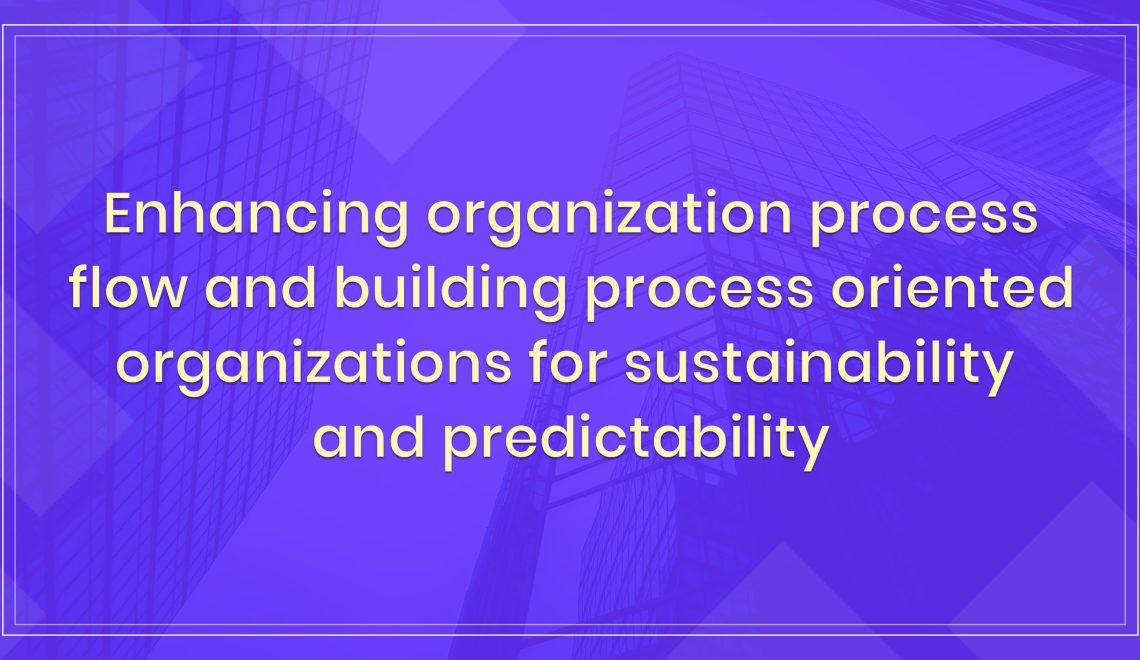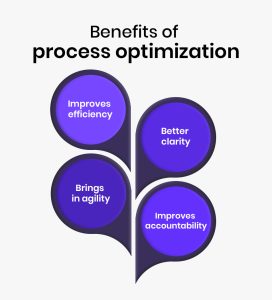
Process orientation or people orientation – which is ideal for an organization? Here is a brief insight into this interesting business topic. I have shared some of my thoughts on how to improve organizational process flow and build a process-centric organization and what I deem as the benefit of going process-centric. Hope you will enjoy reading it.
A process-oriented organization runs on a set of well-defined operating procedures. The presence or absence of the owner or managers does not matter in a process-oriented organization. A people-oriented organization is heavily dependent on certain key individuals and without them, the business fails to run successfully. Small retail shops can be cited as an example of a people-oriented organization while multinational companies are a good model of process-oriented organizations.
What is the organization process?
An organization identifies the work to be performed and also the authorities and roles for performing the task efficiently in order to achieve common goals. Communication, common goals, and willingness to serve are the characteristics of an organization. In this context, the organization process refers to all activities that define the business goals and establishes the processes and resources that can help to reach the business goals. Some examples of organizational processes are managerial processes, infrastructure processes, etc. Clear and specific organization process management and improvement provide transparency to the various stakeholders about the activities and business goals and ensure better business performance.
Importance of organization process flow
The organizational process flow is essential to enable the various stakeholders to work together without conflict and provide clarity on the need for different activities. It requires that all the departments work together as a single unit and delegate roles and responsibilities in a productive manner. Well-defined organizational process management brings higher focus and clarity to the overall business goals. It also infuses the right level of authority and fosters growth.
Why is process-centric is recommended over people-centric?
In a process-centric organization, it is the process that drives the business to achieve the results and not the people.
The term process-centric might bring a picture of an organization that runs on unnecessary documentation and follows a rigid structure with little room for innovation or creativity. This is absolutely wrong! The processes are not constraints for the organization; instead, well-defined processes are clear channels to provide visibility into the functioning of the organization and also to re-engineer the process if required.
- The process-centric approach can positively affect all aspects of a business right from improving employee productivity to achieving business sustainability. Any business that has its goals set on continuous growth and expansion should move to a process-oriented approach than a people-oriented one.
- Process-oriented organizations align the execution of tasks with the business strategy better than people-centric ones. Each employee is clear on his task and also on how it contributes to the overall business performance. This can improve employee motivation and synchronize their efforts into one whole.
- Going process oriented eliminates human emotions from the business functioning. Decisions are made based on the indicators and data rather than on biased judgments. Top management can focus on the immediate and crucial problems, sidestepping the irrelevant ones.
- Market dynamics are easily managed as a process-oriented organization is more agile to changes than a people-oriented one. Emerging market trends or competition are easily captured and the process can be reengineered to adapt.
- Process orientation improves transparency in the business. There are no behind-the-scenes decisions by key individuals. Each action and strategy is clearly defined and open to examination.
- In a people-centric organization, the absence of a key individual leads to poor business performance. Knowledge is centered around the keyman and the person quitting the company can lead to knowledge loss. However, a process-centric organization has a set of defined procedures that are independent of people and the knowledge is easily transferable to new hires.
Business process optimization is crucial
Simply put, business process optimization is improving business processes. It is a method of adjusting a business process and optimizing it for a set of parameters and thereby achieving efficiency. It can include steps to eliminate redundancies, streamline workflows, and improve communication.
Benefits of process optimization

Here are the benefits that process optimization can bring to a business.
- Improves efficiency – Many redundant steps are eliminated and the existing steps are automated to save time, eliminate duplication, and reduce errors. This improves overall employee productivity, resource utilization, and efficiency.
- Better clarity – When there is relevant and accurate information in the organization that provides clarity to each employee on their tasks and responsibilities you can eliminate the confusion and errors in the process. If anything goes wrong, management can easily track where it happened and who was responsible.
- Brings in agility – Optimized business processes inculcate flexibility to adapt to changing business dynamics and implement the required changes. The business becomes more reactive to setbacks and breakthroughs and can take rapid action to stay competitive.
- Improves accountability – With better flow and visibility of information across the organization, tracking and sharing of information improves, thereby bringing total transparency and accountability in the process.
How can a business achieve process optimization?

Here are a few simple steps that an organization can follow to optimize its business process.
- Identify the issue– The first step is to clearly identify the issue that is slowing the process. Now fix the goals and identify what is to be achieved. Do you want to speed up the process? Or do you want the process to perform without any hurdles? How you optimize will depend on these answers.
- Start with the available resources– Once the problem is identified you can go about restructuring the process. Streamline and optimize your available resources because reworking and correcting is the first step to efficiency. What is the wastage that is happening currently? How can the existing process be optimized? Do we need automation to speed up the process? These kinds of issues need to be resolved to eliminate redundancy and wastage.
- Automate the process – Automation saves time and utilizes the resource efficiently. When repetitive tasks are automated it avoids human errors. Consider using business process automation software to eliminate paperwork and routine jobs. This can bring transparency and also reduce the waiting time between jobs.
- Introduce the right technology – By utilizing the right technology you can completely transform the way a process works. It incorporates standardization and improves tracking of the workflow. Communications become centralized and there will be fewer errors and missed deadlines.
- Monitor- The performance of the process should be monitored from both micro and macro angles and updated as required till you achieve the desired performance.
Business process and predictability
Predictability is crucial for a successful business. In a predictable organization, the management knows when to expect an outcome and can forecast production accurately. The teams will behave as per the set process and expectations. This builds consistency in the business. There is a higher level of trust between the management and the employees and also between the organization and its customers. Even during times of market uncertainty, the business will be perceived as a reliable one.
Clearly defined business processes that are repeatable ensure predictability in an organization. To this end, you might need to redesign your business process. Minimize the paperwork involved in the organization. Identify and eliminate the redundancies and wastage to shorten the lengthy process time. Introduce optimal technology and improve communication and workflow across the organization. This can make employees take ownership of their tasks and improve accountability. With clearly defined roles, responsibilities, objectives, and deadlines predictability increases.
If you want to stay ahead of the competition and sustain in the long run take the necessary steps to convert your business to a process-oriented one.
Follow me on LinkedIn
FAQ
What are the 6 organizational processes?
The six organizational processes are departmentalization, designing jobs, establishing reporting structure, defining authority, differentiating among positions, and coordinating activities.
What are the important steps in the process of the organization?
Identifying tasks, delegating tasks, and authority and coordination are important steps in the process of an organization.
How do you create an organizational process?
The steps involved are determining the objectives, evaluating the input and output, and building process maps.
What are the three key activities of process management?
The three key activities are process design, process definition, and process documentation.
What are the three elements of Six Sigma?
The three key elements of Six Sigma are customers, processes, and employees.



